Canon EF 28-135mm f/3.5-5.6 IS USM vs. Canon EF 24-105mm f/4L IS USM

The Canon EF 28-135mm f/3.5-5.6 IS USM lens has been my favorite lens for years. It was my travel lens of choice when I shot on 35mm film. After moving to digital photography, the 1.6x digital sensor caused more to be desired out of this lens (it is still my travel lens of choice). For example, mounted on my D30 at 28mm is equivalent to 44.6mm on a 35mm film. And the Canon EF-S 18-55mm f/3.5-5.6 kit lens that I got with the Digital Rebel is no where close comparable to the capability of this lens. Obviously, the best solution is to get a full-frame DSLR, such as the 5D or the 1D.
But recently, when my 28-135mm lens failed to lock focus, or focused on the background rather than the subject, I thought maybe I should look into getting a secondary travel lens. Heck, having so many back-up EOS cameras, it's almost ridiculous to have no back-up travel lenses. Having carried three prime 28mm, 50mm, and 85mm lenses for traveling, while the 28-135mm lens is out of commission, sure makes the Canon EF 24-105mm f/4L IS USM (with its wider angle) look mighty good.
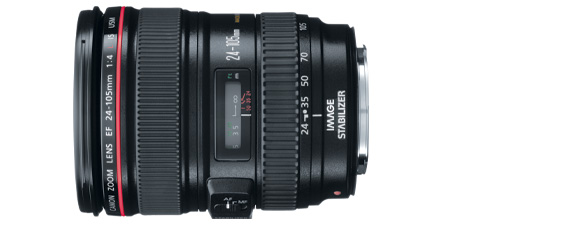
The two lenses are so similar in its zoom range, its aperture, its image stabilization, and its ultrasonic motor that the decision is practically down to wider or longer. However, before committing to the Canon EF 24-105mm f/4L IS USM, I started wondering about the little details. What am I giving up to go a little wider and a fixed aperture? Would I lose the neat macro ability of the 28-135mm lens? So here is a quick comparison between the two lenses to help you and I make the decision.
Specification
| Canon EF 28-135mm f/3.5-5.6 IS USM | Canon EF 24-105mm f/4L IS USM | |
| Release Date | February 1998 | October 2005 |
| Lens Construction (group) | 12 | 13 |
| Lens Construction (element) | 16 | 18 |
| No. of Diaphragm Blades | 6 | 8 |
| Minimum Aperture | 22-36 | 22 |
| Closest Focusing Distance (m) | 0.5 | 0.45 |
| Maximum Magnifcation (x) | 0.19 | 0.23 |
| Filter Diameter (mm) | 72 | 77 |
| Maximum Diameter x Length (mm) | 78 X 97 | 83.5 x 107 |
| Weight (g) | 549 | 670 |
| Street Cost | $409.95 | $1,059.95 |
As it turned out, my fear that the 24-105mm lens has a longer minimum focus distance is unwarranted. In fact, the 24-105mm lens could focus 0.05 m closer and could magnify object by 0.04x more. Wow, I'm surprised that I didn't buy it sooner!
The 24-105mm has a fixed aperture of f/4. At first sight, it seems that it's a step back from the 28-135mm's maximum aperture of f/3.5. But remember that the 28-135mm has a f/3.5 maximum aperture only at 28mm. At 135mm, the maximum aperture is f/5.6. With the 24-105mm lens, I'd lose half a stop at 28mm and gain about half a stop at 105mm. I am perfectly happy with this trade-off, because based on the shutter speed rule-of-thumb, I can steadily hold a 28mm lens by 2 stops compared to a 105mm lens.
Tip
The shutter speed rule-of-thumb says that you can handhold a lens steady using a shutter speed that is as fast as one over the focal length. For example, at a minimum, your shutter speed should be 1/125th of a second to handhold a 105mm lens.
The 24-105mm lens has more lens elements and more lens groups. That could be good or bad. Generally, more lens elements between the subject and the digital sensor means less light travels through. But hey, if the addition elements and groups corrects aberration and improves image quality, I'm all for it. One thing for sure, though, is that more lens elements means more weight (I'll talk about the weight issue later).
The filter diameter of the 24-105mm lens is also more standard to me. Most professional grade lenses use 77mm filter mounts. So I have pretty much standardized on 77mm accessories. The 28-135mm is a black sheep with its 72mm filter mount. So when I use my accessories, I have to use step-up rings. The accessories prevent the flower-shaped lens hood from attaching to the 28-135mm lens. The 77mm filter mount on the 24-105mm lens is a highly desirable feature.
So far the 24-105mm lens has slightly out-performed the 28-135mm lens in virtually all categories. I really can't find much else to pick on, so I can only complain about the size and weight. But what it comes down to is the cost. The 28-135mm lens is an extremely versatile lens with lots of technology; and the price reflects that. I've never spent more than $400 on a consumer-level lens. And I had spent around $500 for the 28-135mm in its early days. Yet, it is worth every penny.
If you think the 28-135mm lens is expensive, you might want to sit down while looking at the 24-105mm's price tag. The 24-105mm costs over $1000! For this price, I can buy two 28-135mm lenses (one for back-up). On the other hand, the 24-105mm lens is a L-series lens with Super UD (ultra-low dispersion) lens element. So far, I have never been disappointed with a professional L-series lens. Yet, like all other L-series lenses, the price is outrageously expensive.
Am I willing to fork out $1000 for a lens? Yes, I've done it before. Am I willing to fork out $1000 for the 24-105mm lens? I don't know. Maybe the MTF charts will help me decide.
MTF Charts
| Canon EF 28-135mm f/3.5-5.6 IS USM | Canon EF 24-105mm f/4L IS USM |
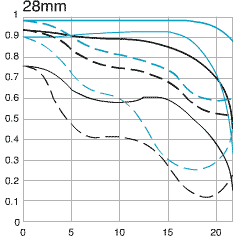 |
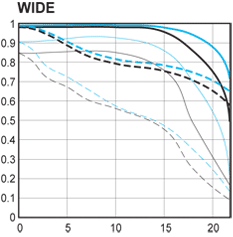 |
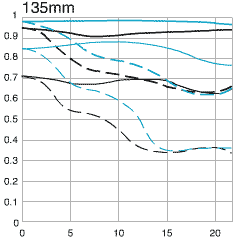 |
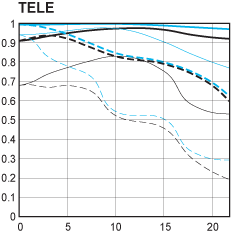 |
Related Links
- Canon EF 24-105mm f/4 L IS USM Lens for Canon EOS SLR Cameras - Amazon User Reviews
- Canon EF 28-135mm f/3.5-5.6 IS USM Standard Zoom Lens for Canon SLR Cameras - Amazon User Reviews
- Canon EW78BII Lens Hood for EF 28-135mm f/3.5-5.6 IS Canon SLR Lens - Amazon User Reviews
- Canon EW-83H Lens Hood for EF 24-105mm f/4L IS USM Lens - Amazon User Reviews
- EF24-105mm f/4L IS USM
- EF28-135mm f/3.5-5.6 IS USM
- MTF chart: How to read - Canon
- Understanding MTF - The Modulation Transfer Function Explained
$10000-above
$5000-$9999
$2000-$4999
$1000-$1999
$500-$999
$200-$499
$100-$199
$50-$99
$25-$49
$0-$24
Gift Certificate

